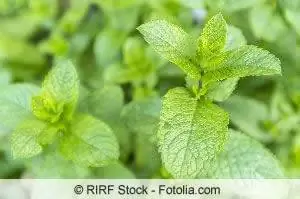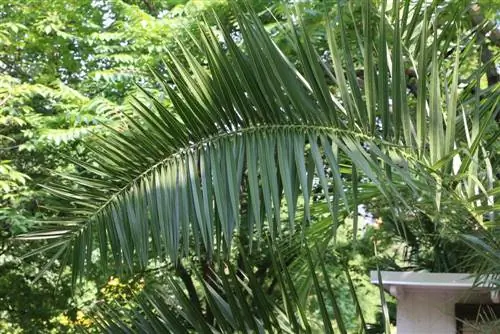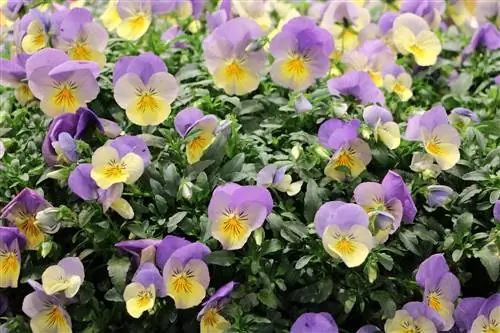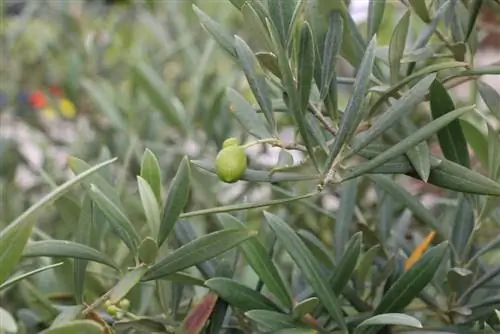- Author admin [email protected].
- Public 2023-12-17 03:39.
- Last modified 2025-06-01 06:48.
Spearmint is a very famous mint that many of us know better as spearmint. It is also a fertile, very easy to germinate and very easy to care for natural form of mint that is just fun in the garden and in pots:
Peppermint, spearmint, spearmint - what’s the difference?
Mints form an entire genus in the mint family, which includes 25 to 30 recognized species. “Recognized” because all of these species interbreed in natural locations, the results are no longer easy to assign. Which has led to many botanists giving mints many names. Spearmint is also a cross between the original mints Mentha longifolia (horse mint) and Mentha suaveolens (round-leaf mint), a very old natural cross. When it comes to names, spearmint is the star: according to prevailing opinion and according to Carl Linnaeus, it has the botanical name Mentha spicata. Other botanists gave this Mentha nicknames from atrata to w alteriana, 84 names for one plant.
These incredibly many spearmint names clearly show three things: that it is a hybrid of considerable importance (otherwise not so many botanists would have de alt with it), that botanists are probably a little vain (because they are under Accepting scientific confusion, always giving new, own names) and that shopping based on the botanical name does not necessarily have to lead to the right result for every plant (e.g. if you need exactly the right variety for a famous recipe). Curly mint is simply another German name for spearmint, and peppermint, Mentha ×?piperita, is the result of a cross between spearmint and water mint (natural cross, Mentha spicata × Mentha aquatica). Of the Mentha spicata itself there are two subspecies, the M. spicata subsp. spicata (the most common spearmint) and the Mentha spicata subsp. condensata (a southeastern variant), but the cultivars are more important for the gardener:
One mint, many flavors
In addition to the natural form, there are some varieties of Mentha spicata that differ quite a bit in aroma and/or height, color and shape of the leaves:
- Mentha spicata in its natural form is said to taste sweeter than peppermint and not be as spicy because it contains less menthol
- Mentha spicata 'Black Spearmint', the real spearmint, has the well-known high content of the "mint active ingredient" menthol and a very unique aroma, strong scent, grows up to 80 cm high
- Mentha spicata 'Crispa', curly mint, high menthol content and light caraway aroma, has curly not only in the name, but also in the leaves
- Mentha spicata 'Lithuania', Memel mint, rather delicate mint with red stems, is said to produce a very soft and full peppermint aroma
- Mentha spicata 'Marroccan', Moroccan mint, likes sunny locations, not as vigorous as other varieties, has a rather low menthol content and a sweet, fresh aroma that is known from Arabic teas
- Mentha spicata 'Nane', Turkish mint, clear menthol taste with a slightly peppery note
- Mentha spicata “Swiss”, Swiss mint, provides a type of minty lemon aroma that is good for cocktails and desserts
- Mentha spicata 'Ukraine', Ukrainian mint, a type of mint that is particularly rich in menthol
- Mentha spicata ssp. hispanica, Spanish mint, most common type of mint in Spain, North Africa and Portugal, fresh mint flavor for sweet and savory dishes
- Mentha x spicata v. crispa, English spearmint, vigorous mint with round leaves and intense aroma for jelly and typical English mint sauce
- Special cultivars should be planted every two years, otherwise they could revert to the original mint (which also tastes good)
Sowing and cultivation in the garden
Spearmint grows pretty much everywhere from Europe and the Caucasus region southwards, in all temperate climates, so it naturally thrives here. It therefore doesn't have any major demands on the location; it likes to grow just as much in bright, sunny places as it does in partially shaded places. However, if the mint gets a few hours of sun every day, the aroma of its leaves becomes more intense. The location should offer the mint enough space; it grows in a ground-covering or creeping manner and spreads out to a greater or lesser extent depending on the variety. Spearmint is ideal for completely greening a location that is still sparsely overgrown, which it then plows through vigorously with its rhizomes. This is not desirable in locations with pretty neighbors; the following applies here: You can keep the mint under control by using competitive plants, but you should keep in mind that such competition requires energy, which can be somewhat at the expense of leaf formation and aroma (at least if this competition is intended to keep the plant under control in the long term). If the mint is able to assert itself against weak competitors, it will only become stronger.
Spearmint tolerates nutrient-rich soil and prefers to grow in clay soil that contains a lot of organic material. The soil should be permeable and relatively moist, of course without causing waterlogging. Very nutrient-poor or very sandy soils can be enriched with humus soil or compost. You can grow Mentha spicata from seeds; like all climatically suitable, more original plants, it germinates easily in our gardens. If you want to cultivate a specific variety, you should get seeds from an (organic) dealer and not from your neighbor. Most cultivars do not produce varietal seeds, so you would get a mint, but not necessarily the one you planned. This is how sowing works:
- It is best to mix fine mint seeds with sand so that they can be sown more evenly
- You can prefer mint in seed trays indoors, growing as described below under “Sowing and care in pots”
- Sowing directly into the bed is also possible, but you have to be prepared for small animals to nibble on a few seeds
- It doesn't matter, you can look in these places, the mint is perennial (or wait until the mint itself closes the gap)
- Mint should only be sown outdoors after the Ice Saints in mid-May
- You can also sow mint later; strong plants must be able to develop by winter
- During the germination phase, the soil must not dry out and keep it evenly moist
- You can prick out the seedlings when they have their second pair of leaves
- You can also let nature take its course, weak plants will eventually be eliminated
You can also buy young plants and plant them out; well-stocked nurseries usually have them available from March to September, strong mint plants can be planted until late autumn.
Care in the garden
You can hardly call it “care” for a mint:
- Keep moist until rooting, logical
- If you didn't plant the mint in midsummer, just water it once or twice after planting
- Maybe water a little if it hasn't rained for days/weeks
- But you don't have to, as long as the mint isn't visibly thirsty
- Until then it will only become more aromatic
- You could fertilize a little if you want to get bumper harvests
- But it doesn't necessarily have to be, mint grows everywhere and is used to grief
- If you want to fertilize: Be careful with the fertilizer!
- Some artificial fertilizers taste very good in tea later
- Some organic fertilizers (manure) but also
Sowing and care in pots
If you know gardens in which mint plants in favorable locations are not prevented from developing by vigorous competitors, you might prefer to plant your mint straight away in a pot from which it cannot spread. No problem, it's very easy:
- The best soil is garden soil with a little sand mixed in
- Alternatively, use commercially available substrate, please without fertilizer
- Wet the potting soil well
- Distribute seeds evenly, cover with around one centimeter of soil
- Place the sowing container in a bright place with temperatures around 20 °C
- The seedlings should be visible after just under 2 weeks
- Keep warm and moist until the second pair of leaves appear, then prick out
- Loose up the root area with a toothpick and pull out individual mini plants so that the others have more space
- Cultivation continues in larger pots in normal soil with medium nutrient content
- The young plants should remain indoors for around 2 weeks
- Then they can be planted on the balcony/terrace or in the garden
There are lots of (beautiful, colorful plastic) sowing sets available in stores for prices starting at around €20. You can buy it (if you have too much money), but it is also important that the mint is referred to by its botanical name. There is a lot going on online at the moment, especially with these sowing sets, and growing herbs in the home is currently a top trend. You can easily spend € 300 on an Internet trading platform for a small indoor greenhouse, equipped with LEDs, the technology of which is unknown on the site and on the entire Internet, you can choose organic mint seeds based on the photo, costs 4, - € (without specifying the quantity, the seed producer, the botanical name, the species or the variety), and organic soil is also available, 1 kg for 7, - € - be careful, such a start-up that has been highly praised by several media outlets maybe wants to gild his front yard.
Approx. 620 grain organic seeds of spearmint, Mentha spicata in the original form, are also available online for €1.60, a good herb nursery has all the varieties mentioned above and 30 other varieties of mint for you. You can pick up a little soil for cents (or for free) at the nearest public compost heap, you can find a box (also a real design model), you don't need LED lighting for mint if you don't live in a cave. Just a little water every now and then and a little organic liquid fertilizer for herbs during the growing season, the pot can survive down to -15 °C in winter (garden: -25 °C) and needs to be watered on frost-free days.
Conclusion
Spearmint is a great herb that is available in an amazing range of varieties. Once a mint has gained a foothold, it is easy to care for, has good winter hardiness and can even spread quite a bit in the garden.






